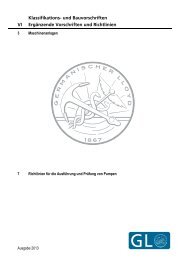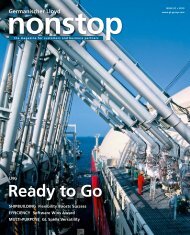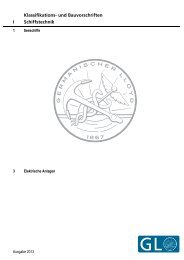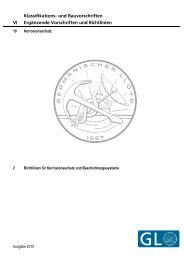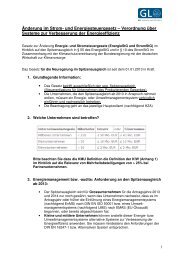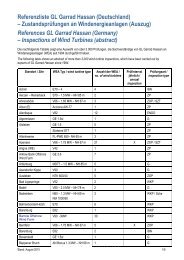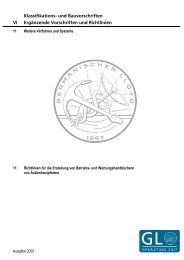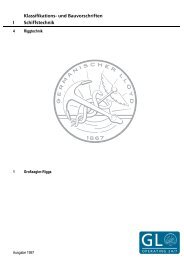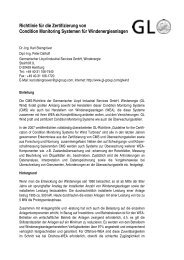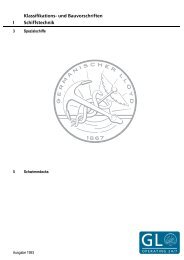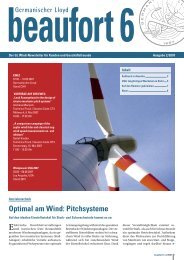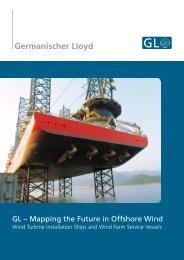(IV-7-3) General Safety
(IV-7-3) General Safety
(IV-7-3) General Safety
You also want an ePaper? Increase the reach of your titles
YUMPU automatically turns print PDFs into web optimized ePapers that Google loves.
Rules <strong>IV</strong> Industrial Services<br />
Part 7 Offshore Technology<br />
Chapter 3 <strong>General</strong> <strong>Safety</strong><br />
Section 2<br />
Marking Platform<br />
Section 2<br />
Marking Platform<br />
A <strong>General</strong> ....................................................................................................................... 2-1<br />
B Substation Marking Equipment................................................................................... 2-1<br />
A<br />
<strong>General</strong><br />
A.1 Visual marking<br />
A.1.1 The parts of substructure above the water level as well as the topsides of the installation shall<br />
be painted according to local authority requirements to facilitate best visibility for the ship traffic (e.g. yellow,<br />
see e.g. IALA O-139).<br />
A.1.2 The installation shall be also marked with nameplates for close-up range identification, visible<br />
from all sides of the platform. The identification marking shall be visible during day and night time and<br />
shall be illuminated during darkness. Identification shall be generally provided with black letters/numbers<br />
of 1m height on yellow background.<br />
Detailed font type, location and illumination of identification marking shall be agreed with the local authority.<br />
For the installation in German waters for example please refer to the requirements (WSD Richtlinie)<br />
for an approved “Kennzeichnungskonzept” and “Umsetzungsplan”.<br />
B<br />
Substation Marking Equipment<br />
B.1 Offshore units and installations fixed at the operation site are to be equipped with nautical<br />
facilities conforming to the IALA Recommendations for the Marking of Man-made Offshore Structures<br />
(IALA O-139) and the requirements for safety of navigation of the coastal state in whose waters the site is<br />
located. These may include signal lights and sound signaling devices for fog as well as other systems<br />
such as Radar beacons, Sonar or Automatic Identification System (AIS, see IALA A-126).<br />
B.2 AIS, signal lights and sound signalling devices for fog which transmit a coded signal for the<br />
identification of the offshore structure are to be provided with their own emergency battery. The capacity<br />
of this battery, assuming simultaneous operation of all consumers, is to be rated to provide a supply for at<br />
least 96 hours, unless some other period is specified by national regulations.<br />
B.3 The coding and range of the radio, visual and sound signalling equipment are governed by the<br />
national regulations relating to the site.<br />
B.4 The switchboard for the signalling equipment is preferably to be sited in a permanently<br />
manned room, e.g. the control station or an equivalent location. The switchboard IP rating shall be in line<br />
with its installation location according to the requirements as set out in GL Rules for Electrical Equipment<br />
(<strong>IV</strong>-7-5).<br />
B.5 Each signalling device is to be supplied from the switchboard by its own feeder which is to be<br />
protected by a fuse or automatic circuit breaker.<br />
B.6 The failure of a signalling device is to be indicated visually and audibly and shall be also indicated<br />
in the station control system.<br />
B.7 The switchboards are to be supplied from the emergency switchboard and a suitable emergency<br />
battery fulfilling the requirements as mentioned in GL Rules for Electrical Equipment (<strong>IV</strong>-7-5).<br />
Edition 2013 Germanischer Lloyd Page 2–1




